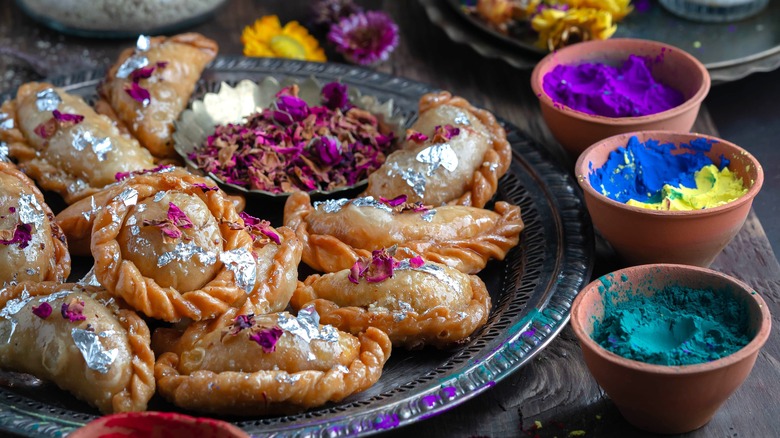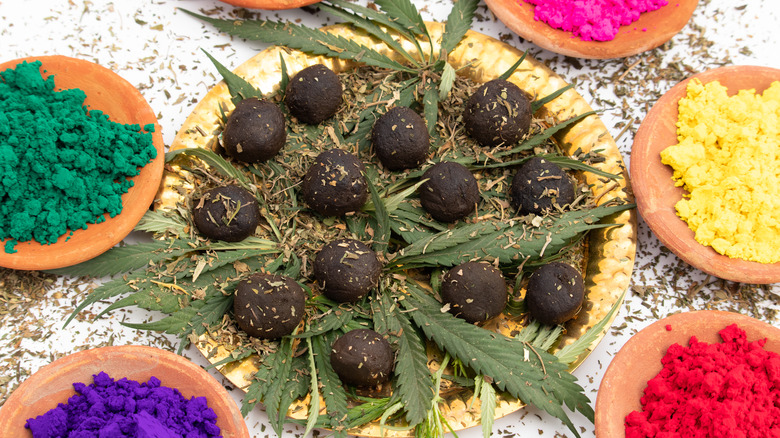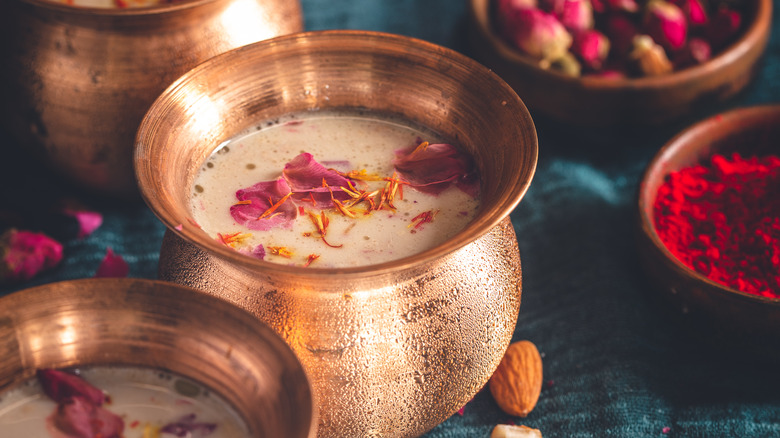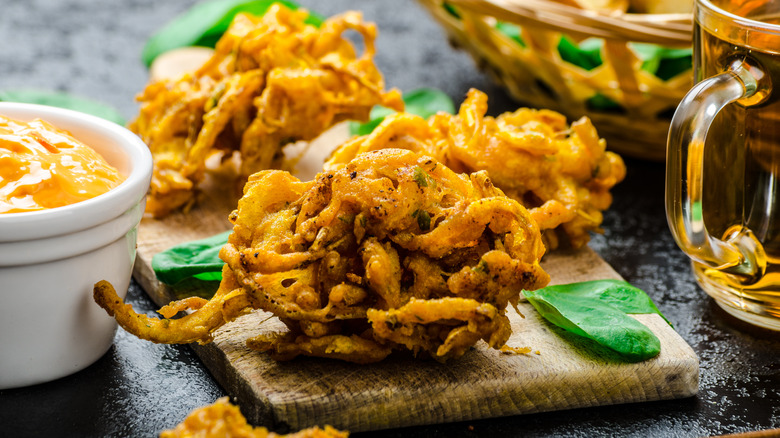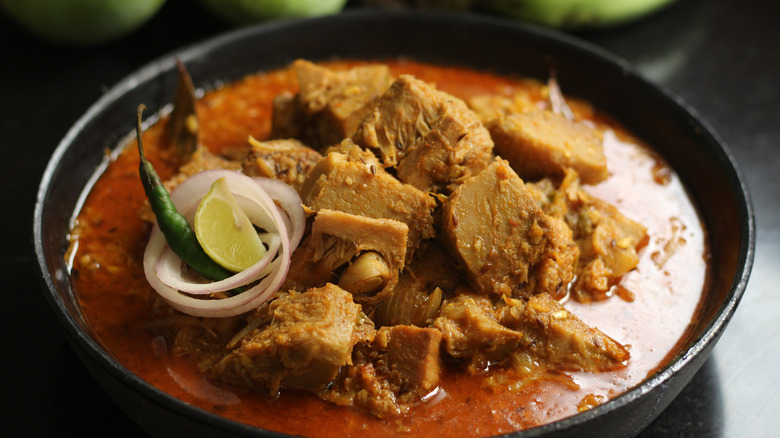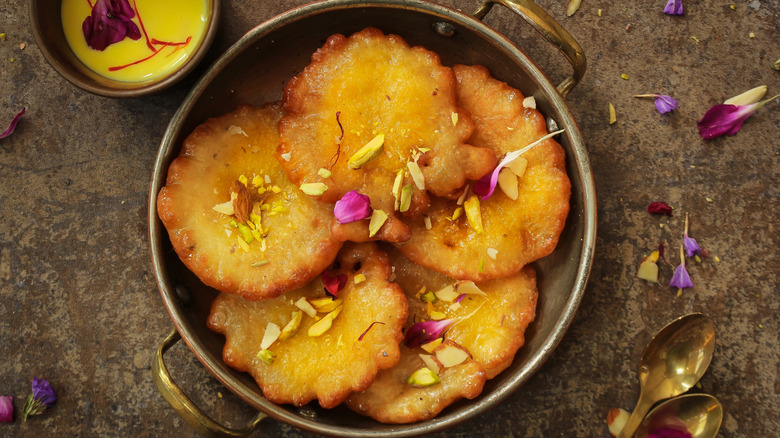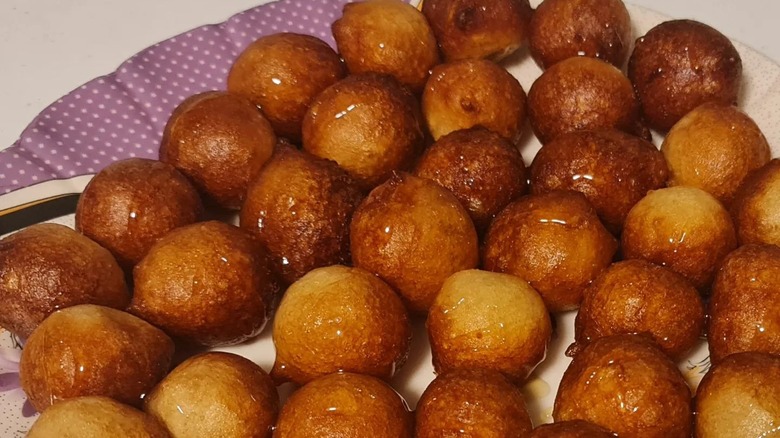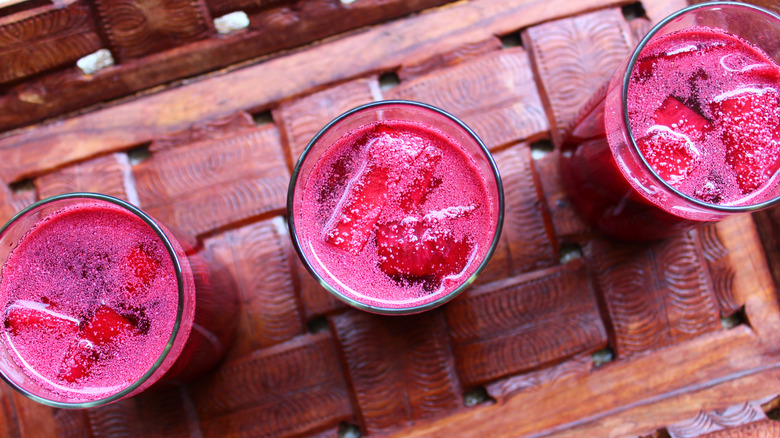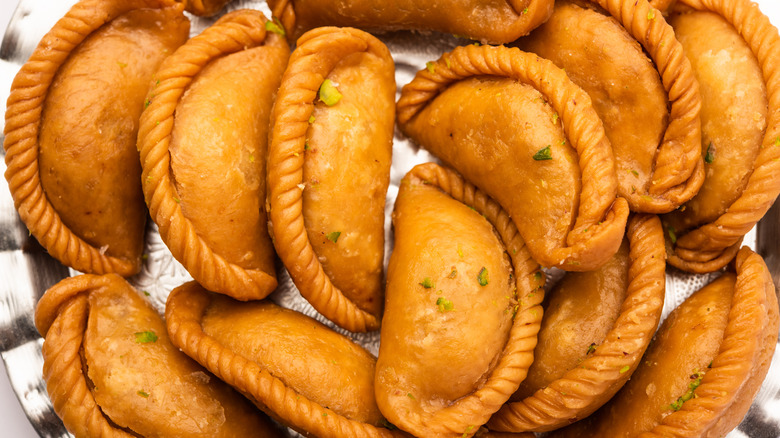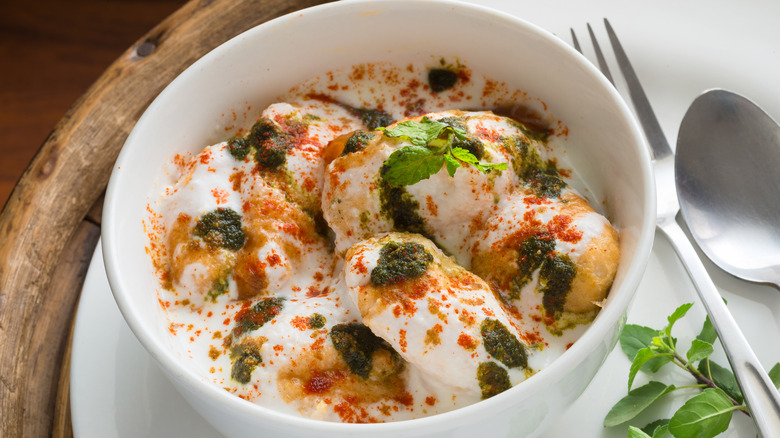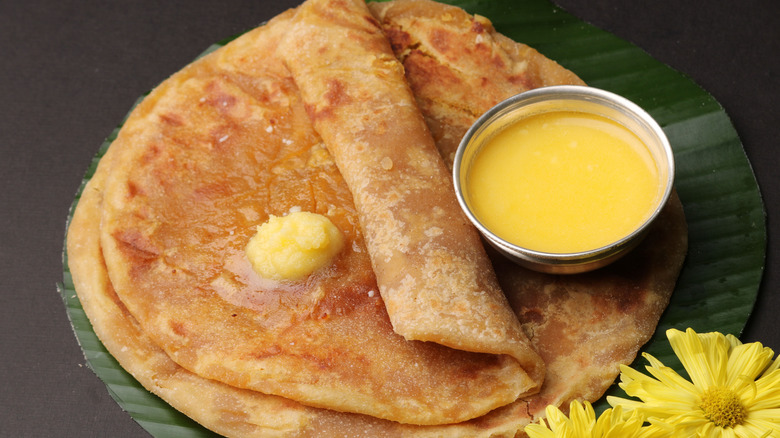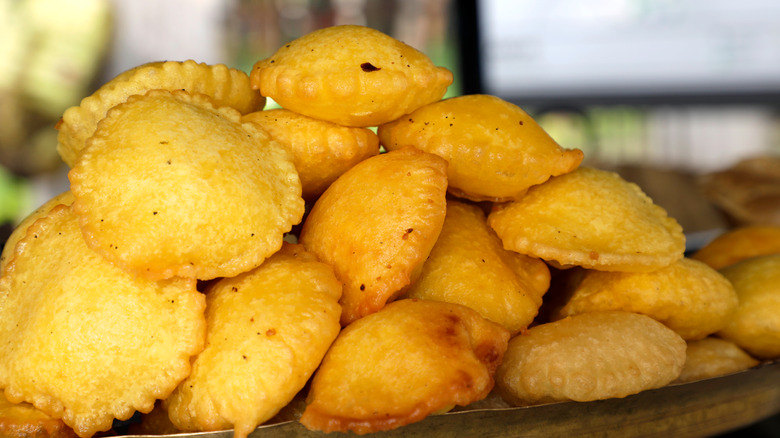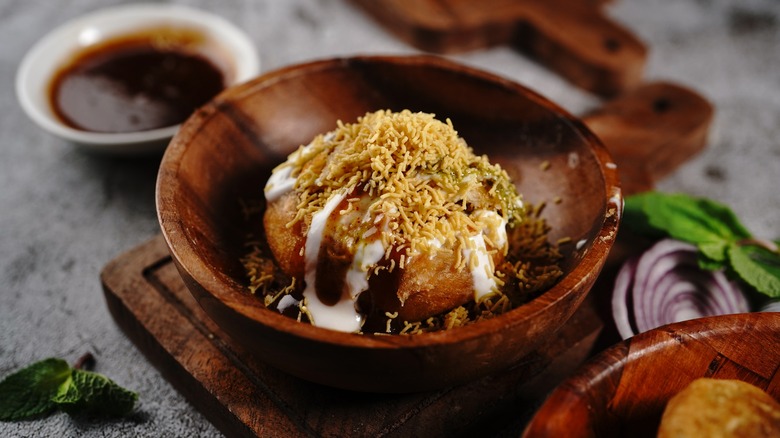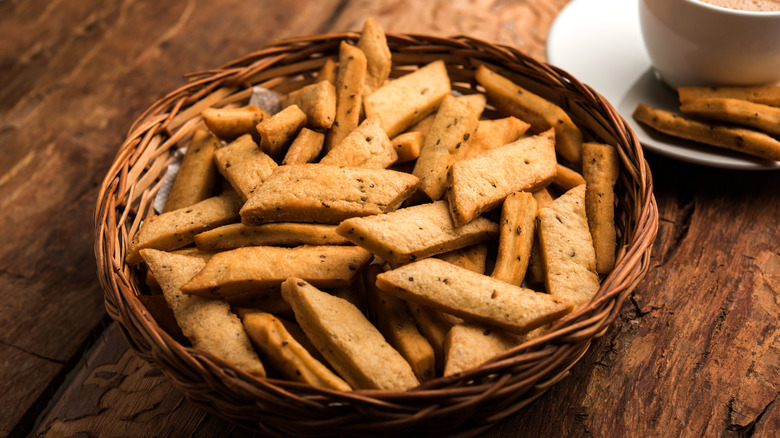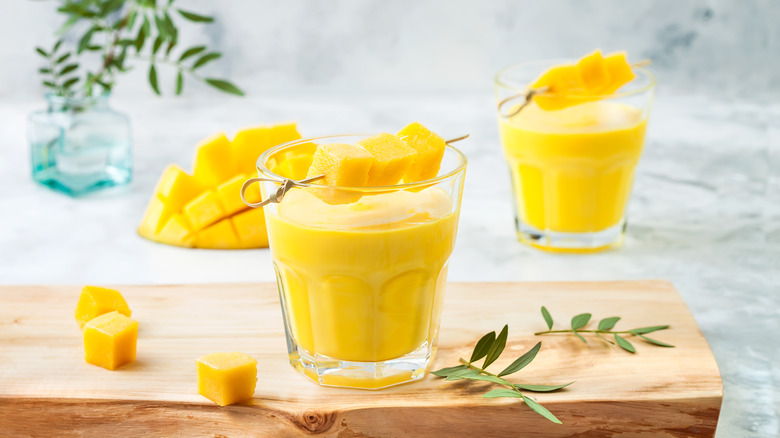14 Traditional Foods And Drinks You Must Try For Holi, The Festival Of Colors
Dharmic religions, such as Hinduism, Buddhism, Jainism, and Sikhism, originated in India, a country rich with traditions and culture. As a nation with so much diversity in beliefs, the Indian people have a plethora of festivals to celebrate; among the Hindu festivities is Holi. Also known as the festival of colors, this event takes part over two days every year and marks the end of winter and the beginning of spring.
The first day of Holi, also known as Chhoti Holi or Holika Dahan, marks the triumph of good over evil. The next day — referred to as Rangwali Holi, Dhulandi, Phagwah, or Badi Holi — people from all walks of life take to the streets and throw colorful dry powder over each other in the renowned color play. Of course, evening feasts await, too, so why not cook or try out some tempting traditional food and drinks for the occasion? Inspiration awaits...
Bhang (cannabis leaves)
You've likely heard of "weed" — produced from dried cannabis leaves — but what about bhang? It originated in ancient India and involves drying, grinding, then soaking the leaves of the cannabis plant to form a thick paste that people can add to food and drink. While the cultivation, production, and sale of the plant's resin are illegal in the nation, its laws do not mention its leaves; this loophole permits the production of bhang (via Vice).
According to Hindu mythology, the churning of the ocean of milk (Sagar Manthan) caused a little nectar to fall to the ground — creating the cannabis plant. However, it also resulted in the release of a toxin called halāhala. As the tale goes, the Hindu god Shiva consumed this poison to save others, but bhang was the treatment. Additionally, stories note that bhang's medicinal properties awoke the god from a great depression on the day of Holi after losing his wife. Therefore, perceived as a "gift from the gods," people celebrate the festival by making cannabis-infused foods like bhang lassi, pakora, and thandai.
Thandai
Picture sunny, hot, and balmy evenings with average temperatures over 90 degrees Fahrenheit. India in March is a delightfully summery affair; while ultimately not reaching the blistering heat of later months, a cooling drink offers a welcome respite from the warmth. That's why thandai, a creamy, nutty, sweet drink that tastes like heaven, has become synonymous with this time of year, particularly Holi.
Often served in clay or brass kulhad (cups), creating the beverage starts by grinding nuts (typically almonds, cashews, and pistachios), seeds (melon, fennel, and poppy seeds are widespread), cardamom, black peppercorns, dried rose petals, and saffron into a paste. Next, the nutritious mixture is added to sweetened boiling milk and chilled overnight.
Those feeling particularly adventurous can infuse thandai with bhang. It's easy to make the paste or powder (the paste is more authentic); however, if you're traveling in India, both Uttar Pradesh and West Bengal are teaming with shops offering freshly made bhang thandai. If all this sounds too out of your comfort zone, you can substitute the bhang for gin — the sweet and spicy notes pair perfectly with the creamy, floral beverage and still provide the same effect.
Pakora
For us, deep-fried food is the ultimate indulgence. And while crispy onion rings, buttermilk fried chicken, or potato fries may be the most popular fried foods in the U.S., other countries have their fair share of delicious crunchy snacks to experience. India is no exception; from samosas to medu vada, the nation boasts an unparalleled variety of street foods. However, pakora is the most widespread. Beloved from state to state, the morsels can be found wrapped in newspaper from street-food stalls or enjoyed at home with a cup of tea on rainy days.
Pakora can be made from any vegetable, although onions are the most common. Other traditional versions are made with paneer and bread, while a chicken and haggis variety has gained a cult following in British Indian restaurants. For Holi, a special preparation called bhang pakora involves grinding cannabis leaves to a paste and adding them to the batter.
No matter which assortment you choose, the standard recipe for the dish requires you to dip the main ingredient in a spiced chickpea flour batter, then fry it. The result is crispy, nutty, fiery hot bites that taste sensational dunked in a bowl of cooling raita or served alongside an Indian feast.
Kathal ki sabji
Like tofu and seitan, jackfruit has been eaten in Asia for centuries, unknown to the rest of the world. It's believed that it originated in South India before spreading to other parts of South-East Asia. It wasn't until recently that the produce grew in popularity in the West due to the increase of people following a plant-based diet. However, even today, India remains the number one producer of jackfruit worldwide.
With centuries of culinary experimentation, it's unsurprising that the country has delivered some of the most delectable jackfruit recipes. The most ubiquitous is kathal ki sabji (jackfruit curry). It can be prepared dry or saucy (we recommend saucy) and boasts a meaty texture that holds up to the richly spiced, aromatic base. Kathal ki sabji is enjoyed all over India but holds a special place of honor in Holi feasts in Bihar and Jharkhand, where jackfruit grows aplenty.
Malpua
When you hear the word "pancakes," you likely think of the fluffy American flapjack drizzled with maple syrup or perhaps delicate French crêpes served with a dash of lemon and sugar. As it turns out, India has a unique version of this prized dessert called malpua.
Although the texture of this dish is soft and fluffy with delightfully crisp edges, you may be surprised to learn that, unlike most western pancakes, they are eggless. Instead, the light texture is achieved by vigorously beating the mix of wheat flour, milk, fennel seeds, and cardamon for a few minutes.
Each state and household in India has a different recipe for the sweet treat; some prefer to add yogurt for a mild sourness, while others include semolina, adding an extra crunch and nuttiness to the batter. After making the batter, people fry the malpua in ghee — but that's not all. Next, the malpua soak in jaggery syrup, infusing them with a sweet caramel flavor. Finally, the patties are plated with thick and creamy rabri: homemade condensed milk flavored with saffron, nuts, and rose water. The final dessert is mouth-wateringly decadent and worthy of any Holi dinner table with its vibrant garnishes.
Gulgule
Who would have thought that the plant-based doughnuts of your dreams were waiting for you in India? Gulgule, also known as meethe pue, is a deep-fried dessert with a shape similar to French beignets and a fluffy, light, and pillowy texture. The batter is straightforward and doesn't require many ingredients: whole-wheat flour, bananas, sugar (jaggery), cardamom, fennel seeds, baking powder, and water. Mashed banana is an ideal egg substitute that adds moisture and sweetness to the dish. Baking powder, meanwhile, acts as a raising agent and gives the gulgule their characteristic fluffiness.
After being fried to an irresistible golden-brown color, the gulgule are often sprinkled with sugar or served alongside rice kheer, rabri, or masala chai. You're most likely to find the treat during Indian festivals like Karwa Chauth and Holi — but we think they're worth making at any time of year, especially because they suit those following a plant-based diet.
Kanji
Although research into the benefits of fermented food and drink is relatively new, more and more studies show a definitive link between them and health benefits such as digestive soundness, immune function, weight management, and much more (via Healthline). That could be one reason why, despite the science being unexplored until recent times, foods that undergo fermentation have a long history of being enjoyed worldwide.
Indian cuisine is not unfamiliar with these types of foods; idli and dosa are the standard breakfast for millions of South Indians daily. One obscure gem, however, is the North Indian kanji, a fermented drink made from red or black carrots, chili powder, mustard seeds, and black salt. The mixture is left in the sun for two to five days, then enjoyed as a pre-meal appetizer.
It has a unique flavor that divides opinions, much like the better-known kombucha. What is not debatable, however, is that the drink is rich in probiotics, living microorganisms that help to balance bacteria. Kanji is mainly consumed in winter months, improving immunity during cold and flu season and keeping the body warm. And who can deny that the beautiful deep purple color is perfect for Holi?
Gujiya
No festival is complete without an array of inviting desserts. While a few mouth-watering treats make it onto almost every festive spread without fail, others are specific to distinctive occasions. It's unclear why gujiya has such a pervasive connection to Holi. Yet, in the case of this dish, people often wait with anticipation year-long until the festival comes to sample these delights.
Similar in shape to an empanada or Cornish pasty, gujiya are much smaller than their lookalikes and almost always sweet rather than savory. The pastry is laden with ghee, creating a flaky texture and rich butteriness once fried. And the filling (oh, the filling!) comprises toasted khoya (thickened, reduced milk solids), sugar, cardamom powder, cashews, almonds, pistachios, raisins, and desiccated coconut mixed together. When bitten into, the crispy pastry gives way to a soft, rich, creamy, and nutty flavor.
Variations of gujiya exist across India, with different fillings and names. While it is a must-try North Indian mithai (sweet) found in Uttar Pradesh, Rajasthan, and Madhya Pradesh, the dessert is known as pedakiya in Bihar, ghughra in Gujarat, karanji in Maharashtra, karjikayi in Tamil Nadu and somas in Karnataka. In South India, the filling generally has a higher proportion of coconut and no khoya.
Dahi vada
Are you one of those people who shun lentils, plagued by memories of flavorless soups? Or perhaps you're an ardent supporter, always looking to try new recipes featuring the protein-rich pulse? Either way, Indian cuisine is for you: lentils are used in many ways, from street food to snacks, breakfasts, soups, curries, and desserts — even the popular Holi snack, dahi vada.
This dish was first mentioned in written texts from the 12th century as "kshirvata." Surprisingly, the recipe hasn't changed much since then. Dahi vada are fluffy, savory doughnuts made from white lentils, which, when soaked, develop a delightfully spongy texture and mild flavor. The snack is topped with fresh yogurt, sour and tangy tamarind and fiery coriander chutneys, crispy chickpea flour noodles, and fresh pomegranate. The explosion of flavors is complex but overwhelmingly refreshing and cooling — perfect for enjoying after the tiring color play of Holi.
Puran poli
Almost every country has a unique type of flatbread that forms an essential part of their cuisine. India has an incredible diversity of the dish, with the most commonly known being chapati (roti) and paratha. However, hundreds of regional variations exist, from simple doughs to multigrain, spiced, and stuffed flatbreads. Puran poli falls in the latter category and hails from the Western state of Maharashtra.
To make the stuffing — puran — one grinds cooked chana dal (yellow lentils) into a paste and cooks it with copious amounts of ghee, sweet jaggery, nutmeg, and cardamom. The dough (poli) is wrapped around the stuffing and cooked on a hot tawa until a nutty aroma wafts through the house and the bread turns golden brown. It's served hot with more ghee (called toop in Marathi) and saffron-infused cold milk. In Maharashtra, puran poli is the predominant festive dessert, served at all major festivals, including Diwali, Ganesh Chaturthi, and Holi.
Dhuska
Another gem from an oft-underexplored region of India, dhuska is a traditional festive breakfast dish from the eastern states of Bihar and Jharkhand. Interestingly, although the dish's batter has similarities to pancakes — once cooked, it resembles fluffy bread — unlike this food, it is gluten-free. Instead of wheat, the recipe utilizes soaked chana dal, urad dal (black lentils), and rice. Green chili-ginger paste, turmeric, asafoetida, and ajwain each add to the flavor, color, and irresistible aroma of dhuska once it's fried in mustard oil.
Because the recipe uses a high proportion of lentils, the dish is rich in crucial antioxidants, potassium, fiber, and protein, all at a low cost (per WebMD). The batter also undergoes a four-hour-long fermentation process, which improves digestibility, according to a study from Plant Foods for Human Nutrition.
People nearly always pair dhuska with a rich, slightly sour, spicy curry made from white or yellow chickpeas, known as ghugni. Alternatively, a homely yet comparatively morish option is a potato curry that couples with the nutty lentil dhuska.
Kachori
It's time to shine a light on the unsung cousin of the samosa: kachori. Similarly to its more famous counterpart, it is a popular deep-fried street food usually enjoyed as a morning or evening snack. The crispy "khasta" pastry encases a range of fillings; each has a unique flavor, with spiced and mashed lentils, peas, potato, onions, or paneer cheese being the bestsellers. The shape remains the same: disk-like and slightly puffed.
Kachori is incomplete without a dollop of chutney on the side, such as zesty and herby mint and coriander, tangy tamarind, or the old favorite tomato sauce. Street vendors ensure they cater to everyone by serving a fried green chili pepper on the side to spice it up or a spoonful of yogurt to cool it down. Raj kachori, known as "the king of all kachori," is supersized and often topped with extra chickpea flour noodles, deep-fried lentils, and fresh herbs.
The dish is so popular during Holi because it's the perfect quick snack to eat on the go — you better eat it speedily before you get color powder thrown on you!
Namak pare
No Indian festival can be complete without preparing a wide array of snacks weeks in advance, ready to nibble on for the special day. One of these dishes is namak pare, and oh boy, they are seriously addictive. To make these little bites, one uses all-purpose flour, whole-wheat flour, semolina (for crunch), salt, and various spices such as black pepper, ajwain, cumin seeds, and sesame seeds. The dough is rolled thin, cut into small diamond shapes, and fried until delightfully crispy. In Hindi, "namak" means salt (to distinguish between namak pare and sakkarpare, the sweet alternative), and "pare" means piece — perfectly describing these slightly spicy, light, and crunchy morsels.
You can store namak pare in containers for around a week, but we're betting they won't last nearly that long. Usually, the little nibbles are offered to unexpected guests or eaten throughout the day, along with a cup of steaming hot Indian chai.
Lassi
The first thing we order at an Indian restaurant is a cooling mango lassi. It's equivalent to law; nothing goes better with spiced dishes than this sweet, fruity, and marvelously creamy yogurt drink. It's easy enough to whip up at home, too: Blend mango chunks (we recommend the world-famous Indian alphonso mango for the best results), full-fat yogurt, milk, cardamom powder, saffron, and sugar in a high-speed mixer until thick and creamy. If you're not a fan of the fruit, don't worry. Lassi comes in many avatars, from plain (simply yogurt-based), salted, rose, strawberry, and even chocolate. Whichever flavor you choose, the beverage is always best chilled, with a couple of ice cubes added to your glass for good measure.
For Holi specifically, adult revelers often add a little bhang to the lassi, turning it a vibrant green color and infusing it with all the properties of the potent cannabis leaves.
